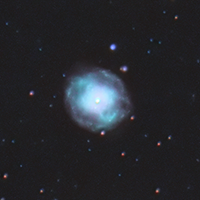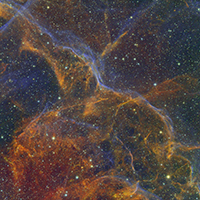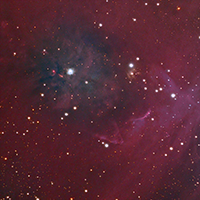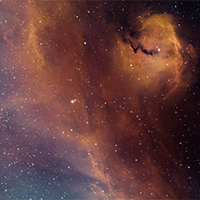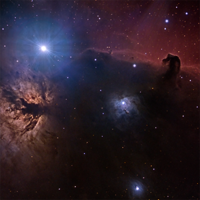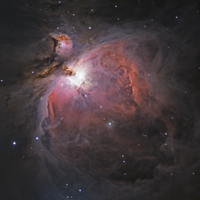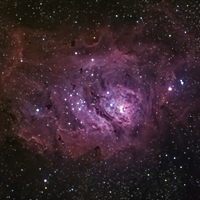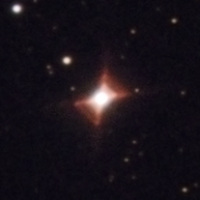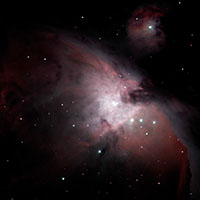Tagged: nebula
18-Apr-2018
NGC4361 is a planetary nebula with spiral arms similar to a galaxy. The star at the center of the nebula is shedding its outer layers while contracting to form a white dwarf.
28-Jan-2018
The Vela Supernova Remnant is an expanding bubble of ionized gas 800 light years away, caused by a supernova explosion 12000 years ago. This image is a small section of the bubble, presented as a narrowband combination of light emitted by Hydrogen alpha, Sulfur II and Oxygen III.
08-Jan-2018
NGC 1999 is a dusty blue reflection nebula, embedded in the hydrogen dust cloud of Orion. This narrow band enhanced image shows the light blue NGC 1999 at the center, with the edge of M42 (the Orion Nebula) at the far right. Also shown in the image is the waterfall nebula, the magenta shock wave between NGC 1999 and M42.
21-Sep-2017
R Aquarii is a symbiotic star system where a white dwarf is drawing material from its binary red giant companion. The extra material is then ejected into space in loops and jets.
11-Aug-2017
After a brief hiatus from astronomy to build a new, larger observatory, I've chosen another difficult target that was surprisingly bright.
19-Jan-2017
The Seagull Nebula a region of nebulosity that lies 1820 light years away, along the border between the constellations Monoceros and Canis Major. It includes the neighboring regions of star clusters, dust clouds and reflection nebulae centered around IC 2177.
04-Jan-2017
Adjacent to the bright blue supergiant star Alnitak shines the ionised hydrogen of the Flame and Horsehead nebulae.
02-Dec-2016
The Orion Nebula is one of the brightest nebulae in the sky, visible to the naked eye. It is seen as the fuzzy middle star in the sword of Orion. The nebula is 1344 light years away and is one of the closest star forming regions to Earth.
03-Aug-2016
Almost everyone has a go at imaging the Trifid nebula, which is composed of 3 different type of nebulae; emission, reflection, and absorption. When I noticed some faint red glow in the background, I decided to try integrating some long hydrogen emission line frames to see if I could get any structure out of it. I'm quite happy with the resulting background structures!
10-Jun-2016
I was lucky enough to snag a second hand 900mm refractor at a good price. I needed a bright target to test it with. The Lagoon Nebula is a giant interstellar cloud around 4077 light years away, classified as an emission nebula and as an H II region.
14-Dec-2015
The unusual shape of the Red Rectangle is likely due to a thick dust torus which pinches the otherwise spherical outflow into tip-touching cone shapes. Because we view the torus edge-on, the boundary edges of the cone shapes seem to form an X. The distinct rungs suggest the outflow occurs in fits and starts.
19-Sep-2015
My original target was the Helix Nebula, but after spending most of Saturday night trying to work out how to use off axis guiding, I gave up and noticed Orion was rising. A nice bright target to use the drift aligned mount on.
08-Aug-2015
A DSLR image of the swan nebula when I was first learning how to do astrophotography
15-Feb-2021
Stars such as our Sun do not contain enough mass to finish their lives in the glorious explosions known as supernovae. However, they are still able to salute their imminent demise into dense, Earth-sized embers called white dwarfs by first expelling colourful shells of gas known as planetary nebulae.
13-Oct-2020
IC 4601 is a reflection nebula within the larger Blue Horsehead Nebula. Reflection nebulae are actually made up of dust that normally appears dark but can reflecting the light of nearby stars.
